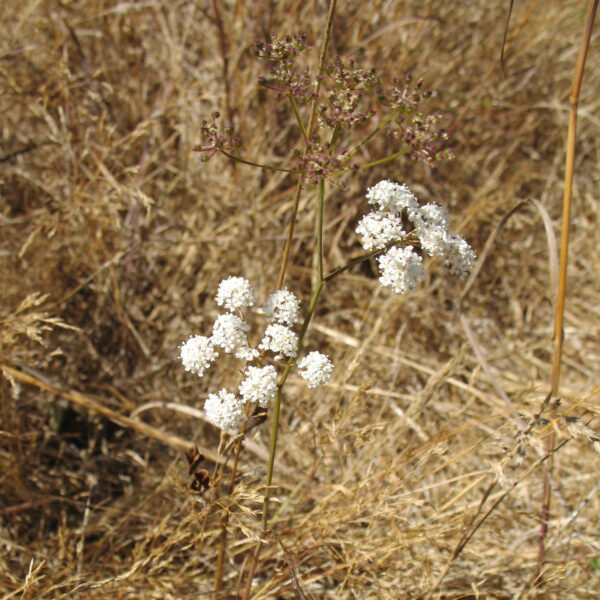Common Yampah
Perideridia gairdneri (H. & A.) Mathias

overview
Slender hairless perennial from a tuberous-thickened root; stems leafy, solitary, 40-120 cm tall. Leaves several, well-distributed along the stem, once or sometimes twice pinnately divided into long, narrow segments, leaf stalks sheathing basally. Flowers white or pinkish, small; several to many in small compact heads united into one to several compound umbels; involucral bracts lacking. Fruits nearly spherical, 2-3 mm in diameter, slightly flattened, hairless and prominently ribbed (Pojar and MacKinnon, 1994). Photo by Moralea Milne.
other names
wild caraway
family
Apiaceae
ecological setting
Dry to vernally moist open forest, meadows and mossy or grassy slopes; low to mid-elevations; scattered but locally common. Occurs from southern B.C. to southern California and east to Saskatchewan, South Dakota and Colorado.
soil texture
Well-drained soils.
nutrients
Nitrogen-medium soils.
soil reaction salinity
Slightly acid to mildly alkaline.
moisture regime
Dry to fresh, moisture-deficient sites.
shade tolerance
Very shade intolerant.
successional status
Climax on drier sites, seral on moister sites.
bec zone subzone status
Meadow communities in Garry Oak ecosystems.
site rehabilitation
Potential reclamation species for dry, open sites.
first nations
Roots boiled and eaten, or dried and pounded to make flour with an anise seed-like taste (Pojar and MacKinnon, Turner 1995).
flowering time
May-June
fruit ripening time
July - August
seed collection time
August
crop intervals
Annual
no seeds per kg
250,000
seed viability
50 - 65 %
collection and abstraction
Hand collect seeds in August when seeds have turned brown and are easily stripped off inflorescence into paper bags.
seed storage
Store seeds in sealed containers at 5º C. Seed will retain viability for up to five years.
fruit seed dormancy treatment
Sow seeds in fall and allow natural stratification, or sow stored seeds in the spring after six to eight weeks of cold, moist stratification.